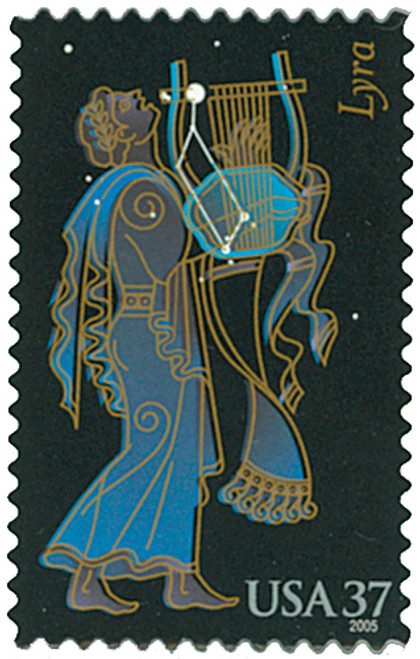
2005 37c Constellations: Leo
# 3945 - 2005 37c Constellations: Leo
$1.00 - $3.20
U.S. #3945
37¢ Leo
Constellations
37¢ Leo
Constellations
Issue Date: October 3, 2005
City: Bloomfield Hills, MI
Quantity: 70,000,000
Printing Method: Lithographed
City: Bloomfield Hills, MI
Quantity: 70,000,000
Printing Method: Lithographed
Centuries ago, people used stars to travel oceans or deserts and to mark the seasons. They named groups of stars, or constellations, after figures from their myths. Some constellations date back 2000 to 3000 years.
Many constellations were named by the ancient Greeks. The constellation Orion is named for a legendary hunter. In one version, the goddess of the hunt, Artemis, fell in love with Orion, but was tricked into killing him. She set his image in the stars.
The constellation Lyra is the harp that Orpheus played after his wife died. When Orpheus was killed, the great god Zeus raised Orpheus’ lyre into the skies.
Leo, the lion, is a constellation connected to the story of Hercules. The Greek hero was ordered to kill the fierce Nemean lion, a nearly impossible task. Hercules’ enemy, the goddess Hera, was so angry at the hero’s success that she raised Leo into the sky.
Pegasus became a constellation, according to a Greek myth, when the hero Bellerophon tried to fly the winged horse to heaven. Pegasus threw Bellerophon off and was immortalized in the stars.
New constellations were added from the 16th to the 18th centuries. In 1929, the International Astronomical Union defined 88 “official” constellations.
U.S. #3945
37¢ Leo
Constellations
37¢ Leo
Constellations
Issue Date: October 3, 2005
City: Bloomfield Hills, MI
Quantity: 70,000,000
Printing Method: Lithographed
City: Bloomfield Hills, MI
Quantity: 70,000,000
Printing Method: Lithographed
Centuries ago, people used stars to travel oceans or deserts and to mark the seasons. They named groups of stars, or constellations, after figures from their myths. Some constellations date back 2000 to 3000 years.
Many constellations were named by the ancient Greeks. The constellation Orion is named for a legendary hunter. In one version, the goddess of the hunt, Artemis, fell in love with Orion, but was tricked into killing him. She set his image in the stars.
The constellation Lyra is the harp that Orpheus played after his wife died. When Orpheus was killed, the great god Zeus raised Orpheus’ lyre into the skies.
Leo, the lion, is a constellation connected to the story of Hercules. The Greek hero was ordered to kill the fierce Nemean lion, a nearly impossible task. Hercules’ enemy, the goddess Hera, was so angry at the hero’s success that she raised Leo into the sky.
Pegasus became a constellation, according to a Greek myth, when the hero Bellerophon tried to fly the winged horse to heaven. Pegasus threw Bellerophon off and was immortalized in the stars.
New constellations were added from the 16th to the 18th centuries. In 1929, the International Astronomical Union defined 88 “official” constellations.










